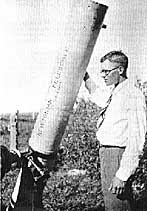ASTRONOMERS
TODAY
 STEPHEN HAWKING (1942 A.D. - )
STEPHEN HAWKING (1942 A.D. - )
Stephen Hawking grew up north of London. He excelled in mathematics; however, at his father's request, he studied chemistry so he could attend Oxford. After taking entrance exams for Oxford, he was awarded a scholarship. While in school, Hawking specialized in physics. After receiving his degree, Hawking went to Cambridge to study relativity and cosmology.
At the end of his first semester at Cambridge (Christmas 1962), he was hospitalized and diagnosed with Lou Gehrig's disease. The disease would eventually worsen and confine him to a wheelchair. Upon completion of his doctorate in 1966, Hawking was awarded a fellowship at Gonville and Caius College, Cambridge. Since 1979 Hawking has held the Lucasian professorship in mathematics, the same chair that was held 300 years earlier by Sir Isaac Newton.
In 1985 Hawking developed pneumonia and almost died. A life- saving tracheotomy was performed but resulted in Hawking losing his ability to speak. He now communicates using a computer system that generates an electronic voice.
Hawking's contributions have been in the areas of general relativity, gravity, and quantum theory, with emphasis in the area of black holes. His research focuses on the attempt by scientists to unite quantum theory and gravity through general relativity into a generalized theory that would span from the smallest subatomic particles to the expanse of the universe.
 CLYDE TOMBAUGH (1906 A.D. - 1997 A.D.)
CLYDE TOMBAUGH (1906 A.D. - 1997 A.D.)
Clyde Tombaugh was an American astronomer who discovered the planet Pluto. In 1929, Tombaugh was hired as a junior astronomer to join in the search for a "Planet X" beyond Neptune. He made world news on March 13, 1930, when his discovery of the ninth planet, Pluto, was confirmed.
Over the next 13 years, he discovered six star clusters, two comets, hundreds of asteroids, several dozen clusters of galaxies, and one super-cluster. He was also instrumental in determining the vortex nature of Jupiter's Great Red Spot, the rotation period of Mercury on its axis and in the development of a new photographic technique to monitor small Earth satellites.